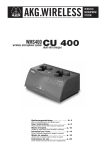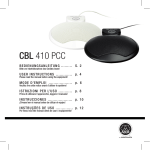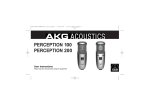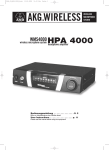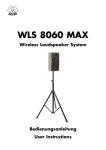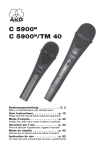Download AKG SPC 4 Specifications
Transcript
SPC 4 BEDIENUNGSANLEITUNG . . . . . . . . . . . . S. 2 Bitte vor Inbetriebnahme des Gerätes lesen! USER INSTRUCTIONS . . . . . . . . . . . . . . . . p. 1 0 Please read the manual before using the equipment! MODE D’EMPLOI . . . . . . . . . . . . . . . . . . . . . . p. 1 8 Veuillez lire cette notice avant d’utiliser le système! ISTRUZIONI PER L’USO . . . . . . . . . . . . . . p. 2 6 Prima di utilizzare l’apparecchio, leggere il manuale! MODO DE EMPLEO . . . . . . . . . . . . . . . . . . . . p. 3 4 ¡Sirvase leer el manual antes de utilizar el equipo! INSTRUÇÕES DE USO . . . . . . . . . . . . . . . . S. 4 2 Favor leia este manual antes de usar o equipamento! Table of Contents FCC Statement ......................................................................................................10 1 Safety and Environment ....................................................................................11 1.1 Safety..........................................................................................................11 1.2 Environment................................................................................................11 2 Description .........................................................................................................12 2.1 Introduction.................................................................................................12 2.2 Packing List ................................................................................................12 2.3 Optional Accessories..................................................................................12 2.4 SPC 4..........................................................................................................12 2.4.1 Front Panel ........................................................................................12 2.4.2 Rear Panel .........................................................................................12 3 Getting Started ...................................................................................................13 3.1 Important Notes..........................................................................................13 3.2. Rack Mounting a Single Antenna Combiner...............................................13 3.3 Rack Mounting Two Antenna Combiners Side by Side..............................13 3.4 Setting Up Antennas...................................................................................13 3.4.1 Placement..........................................................................................13 3.4.2 Mounting Antennas on Floor Stands .................................................14 3.4.3 Wall/Ceiling Mounting........................................................................14 3.5 Wiring..........................................................................................................14 3.6 Powering.....................................................................................................15 3.6.1 Using an AC Adapter .........................................................................15 3.6.2 Using the PSU 4000 ..........................................................................15 4 Operating Notes .................................................................................................16 4.1 Powering Up and Down..............................................................................16 4.1.1 Systems with Distributed Power Supplies.........................................16 4.1.2 Systems with PS 4000 Central Power Supplies ................................16 4.2 Status LED..................................................................................................16 5 Cleaning ..............................................................................................................17 6 Specifications.....................................................................................................17 FCC Statement This equipment has been tested and found to comply with the limits for a Class B digital device, pursuant to Part 74 of the FCC Rules. These limits are designed to provide reasonable protection against harmful interference in a residential installation. This equipment generates, uses, and can radiate radio frequency energy and, if not installed and used in accordance with the instructions, may cause harmful interference to radio communications. However, there is no guarantee that interference will not occur in a particular installation. If this equipment does cause harmful interference to radio or television reception, which can be determined by turning the equipment off and on, the user is encouraged to try to correct the interference by one or more of the following measures: • Reorient or relocate the receiving antenna. • Increase the separation between the equipment and the receiver. • Connect the equipment into an outlet on a circuit different from that to which the receiver is connected. • Consult the dealer or an experienced radio/TV technician for help. Shielded cables and I/O cords must be used for this equipment to comply with the relevant FCC regulations. Changes or modifications not expressly approved in writing by AKG Acoustics may void the user’s authority to operate this equipment. 10 AKG SPC 4 1 Safety and Environment ! 1. Do not spill any liquids on the equipment and do not drop any objects through the ventilation slots in the equipment. 2. The equipment may be used in dry rooms only. 3. The equipment may be opened, serviced, and repaired by authorized personnel only. The equipment contains no user-serviceable parts. 4. Before connecting the equipment to power, check that the primary voltage stated on your power supply is identical to the AC mains voltage available where you will use the equipment. 5. Operate the equipment with a DC power supply with an output voltage of 12 VDC/1.4 A or the PSU 4000 central power supply from AKG. Using a power supply with a different output voltage may cause serious damage to the unit. 6. If any solid object or liquid penetrates into the equipment, shut down the sound system immediately. Disconnect the equipment from the power outlet immediately and have the equipment checked by AKG service personnel. 7. If you will not use the equipment for a long period of time, disconnect the equipment from the power outlet. Please note that the equipment will not be fully isolated from power when you set the power switch to OFF. 8. Do not place the equipment near heat sources such as radiators, heating ducts, or amplifiers, etc. and do not expose it to direct sunlight, excessive dust, moisture, rain, mechanical vibrations, or shock. 9. To avoid damage due to overheating, make sure never to cover or block the ventilation louvers on the equipment front panel. 10. To avoid hum or interference, route all cables away from power lines of any type. If you use cable ducts, be sure to use separate ducts for the audio lines. 11. Clean the equipment with a moistened (not wet) cloth only. Be sure to disconnect the AC adapter from the power outlet before cleaning the equipment! Never use caustic or scouring cleaners or cleaning agents containing alcohol or solvents since these may damage the enamel and plastic parts. 12. Use the equipment for the applications described in this manual only. AKG cannot accept any liability for damages resulting from improper handling or misuse. 1.1 Safety 1. The AC adapter will draw a small amount of current even when the equipment is switched off. To save energy, disconnect the AC adapter from the power outlet if you will leave the equipment unused for a long period of time. 2. When scrapping the equipment, separate the case, circuit boards, and cables, and dispose of all components in accordance with local waste disposal rules. 3. The packaging of the equipment is recyclabe. Dispose of the packaging in an appropriate container provided by the local waste collection/recycling entity and observe all local legislation relating to waste disposal and recycling. 1.2 Environment AKG SPC 4 11 2 Description 2.1 Introduction Thank you for purchasing an AKG product. This Manual contains important instructions for setting up and operating your equipment. Please take a few minutes to read the instructions below carefully before operating the equipment. Please keep the Manual for future reference. Have fun and impress your audience! 2.2 Packing List 1 SPC 4 antenna combiner 1 19" rack mounting kit 2.3 Optional Accessories 2.4 SPC 4 • Check that the packaging contains all of the items listed above. Should any of these items be missing, please contact your AKG dealer. • For optional accessories, refer to the current AKG catalog or folder, or visit www.akg.com. Your dealer will be glad to help. The SPC 4 is an antenna combiner designed for the IVM 4 in-ear monitor system. The antenna combiner allows you to combine the output signals of up to four SST 4 stereo transmitters into a single antenna signal. The SPC 4 will only operate with the SRA 2 W passive directional antenna or RA 4000 W passive omnidirectional antenna from AKG. The SPC 4 can be powered either from an AC adapter with an output voltage of 12 VDC/≥1.4 A (not included) or the optional PSU 4000 central power supply. 2.4.1 Front Panel Fig. 1: SPC 4 front panel. 1 Refer to fig. 1. 1 2 3 2 3 ON/OFF: Pushbutton for switching power to the unit on and off. Status LED: This tricolor LED indicates the following operating conditions: Green: Power to the unit is on, the operating temperature is within the safe range. Orange: Critical operating temperature, the unit may overheat. Red: The unit has overheated or is connected to an antenna not approved by AKG. Switch power to the unit off to avoid damage to the unit. Ventilation grill: The unit incorporates a ventilator for cooling the electronic circuitry. 2.4.2 Rear Panel Fig. 2: Inputs and outputs on the SPC 4 rear panel. Refer to fig. 2. 4 4 5 6 7 12 5 5 5 5 7 6 ANTENNA OUT: BNC output connector for an SRA 2 W or RA 4000 W transmitting antenna. You may also connect this output to a transmitter input on another SPC 4. INPUT 1-4: BNC inputs for connecting one to four SST 4 stereo transmitters. DC ONLY 12 V/1.4 A SPC 4: DC input for an AC adapter with a 12 VDC/≥1.4 A output (not included) for powering the SPC 4. DC ONLY 12 V/2 A SST: DC input for connecting the optional PSU 4000 central power supply for powering the SST 4 transmitters connected to the SPC 4. AKG SPC 4 3 Getting Started 3.1 Important Notes 1. Make all antenna cable connections before connecting the unit to power. 2. Do not connect to the SPC 4 to any antenna other than the SRA 2 W or RA 4000 W from AKG. Using other antenna types may cause malfunctioning of the SPC 4. 3. Position the unit such that the front panel ventilation grill cannot be covered. Obstructing the air intake may cause the unit to overheat. ! 1. Unscrew the four rubber feet (1) from the antenna combiner bottom panel. 2. Unscrew the two fixing screws (2) from each side panel. 3. Use the fixing screws (2) to screw the short bracket (3) to one side panel and the long bracket (4) to the other side panel. The brackets are contained in the supplied rack mounting kit. 4. Install the antenna combiner in your rack. 3.2. Rack Mounting a Single Antenna Combiner Refer to fig. 6. 1. Unscrew the four rubber feet (1) from each antenna combiner's bottom panel and remove the screws (5) from the rubber feet (1). 2. Unscrew the two fixing screws (2) from the right-hand side panel of one antenna combiner and from the left-hand side panel of the other antenna combiner. 3. Remove the plastic covers (3) from the side panels with the fixing screws (2) still on. 4. Insert one connecting strip (4) into each free slot in the side panel of the first antenna combiner, making sure to align the hole in each connecting strip (4) with the appropriate threaded hole in the antenna combiner bottom panel. 5. Fix the two connecting strips (4) on the first antenna combiner using two of the screws (5) you removed from the rubber feet. 6. To join the two antenna combiners, slide the connecting strips (4) on the first antenna combiner through the free slots in the side panel of the second antenna combiner. Make sure to align the hole in each connecting strip (4) with the appropriate threaded hole in the bottom panel of the second antenna combiner. 7. Fix the two connecting strips (4) on the second antenna combiner using two of the screws (5) you removed from the rubber feet. 8. Screw a short bracket (6) to the outer side panel of each antenna combiner using for each bracket two of the screws (2) you removed from the antenna combiner side panels. 9. Install the antenna combiners in your rack. 3.2. Rack Mounting a Single Antenna Combiner Refer to fig. 6. The following hints on placing the antenna apply to any multichannel system, no matter how many channels it may use. 3.4 Setting Up Antennas Reflections off metal parts, walls, ceilings, etc. or the shadow effects of musicians and other people may weaken or cancel the direct transmitter signal. For best results, place the antenna as follows: 3.4.1 Placement 1. Place the antenna near the performance area (stage). 2. Place the antenna at least 5 ft. (1.5 m) away from any big metal objects, walls, scaffolding, ceilings, etc. 3. Do not place the antenna in a wall recess. 4. Place the antenna at least 5 ft. (1.5 m) away from any equipment that may emit RF radiation such as lighting racks, fluorescent lamps, digital effects units, or PCs. AKG SPC 4 13 3 Getting Started 3.4.2 Mounting Antennas on Floor Stands • When mounting the antenna on a floor stand, be sure to proceed as follows: 1. Use the supplied SA 63 or the integrated stand adapter to mount the antenna on the boom of a boom stand. 2. Pull the boom out all the way to one side to make sure the antenna will be at least 28 inches (70 cm) away from the stand. 3. Extend the stand high enough to place the boom at least 6 ft. (1.8 m) above the floor. 4. Wind the antenna cable around the boom. Do not allow the cable to sag below the boom because this may degrade the reception quality. ≥ 70cm ˛ ˛ ˛ ≥ 150cm ˛ Fig. 3: Antenna mounted on a floor stand. 1. Mount the antenna at least 10 cm (4 in.) in front of and at a minimum lateral distance of 50 cm (20 in.) from any walls or other plane surfaces, metal grids, or metal scaffolding. ˛ 3.4.3 Wall/Ceiling Mounting ˛ ≥ 10cm ˛ ˛ ≥ 50cm ˛ ˛ ≥ 50cm Fig. 4: Minimum distances from plane surfaces. ˛ 2. Make sure the antenna will sit at least 15 cm (6 in.) above the floor or 50 cm (20 in.) from the ceiling (or 15 cm (6 in.) if you route the cable to the antenna from above). ˛ ˛ ≥ 50 (15) cm ≥ 15cm 3.5 Wiring Note: ˛ Fig. 5: Minimum distances from floor and ceiling. 1. Connect the ANTENNA output on each transmitter to one of the INPUT connectors on the antenna combiner. Use the shortest possible RG58 antenna cables. 2. If several signals are radiated by a shared antenna, intermodulation of the various carrier frequencies will cause spurious emissions. To avoid technical and legal problems (official limits for RF output and spurious emissions), set the RF OUTPUT level on each transmitter as follows (also refer to the IVM 4 User Manual): • Transmitters Max. RF OUTPUT per transmitter 2 to 4 20 mW ≥4 10 mW If you need to use a multichannel system with a higher RF output, please contact AKG Sales at [email protected]. 3. Connect the antenna to the ANTENNA OUT connector on the antenna combiner. Important! 14 ! • Please note that these antennas may boost their RF output (ERP) in their preferred directions. In order to keep RF output within legal limits, make sure to use antenna cables of the correct length for each type of cable, e.g., RG58: 16 ft. (5 m) for an RA 4000 W or 33 ft. (10 m) for an SRA 2 W. AKG SPC 4 3 Getting Started • To power the SPC 4 you can use either a suitable AC adapter or the optional PSU 4000 central power supply. 3.6 Powering • Do not use any AC adapter other than a type delivering an output voltage of 12 VDC and an output current of 1.4 A or higher. Check that the AC mains voltage stated on your power supply is identical to the AC mains voltage available where you will use your system. Using the power supply with a different AC voltage may cause irreparable damage to the unit. If you connected neither a suitable standard AC adapter nor a PSU 4000 to DC ONLY 12 V/2 A SST, you will need to power each transmitter from a separate power supply. 3.6.1 Using an AC Adapter Important! • • ! 1. Plug the DC cable of your AC adapter into the DC ONLY 12 V/1.4 A SPC 4 jack on the antenna combiner rear panel. 2. Connect the AC adapter to a convenient AC outlet. 1. Connect the DC OUT 1 jack on the PSU 4000 to the DC ONLY 12 V/2 A SST jack on the antenna combiner rear panel. 2. Connect the DC OUT 2 or DC OUT 3 jack on the PSU 4000 to the DC ONLY 12 V/1.4 A SPC 4 jack on the antenna combiner rear panel. AKG SPC 4 3.6.2 Using the PSU 4000 Refer to fig. 8 and the PSU 4000 User Manual. 15 4 Operating Notes 4.1 Powering Up and Down Important! ! • To prevent damage from overloading the antenna combiner power supply, always switch power to the various components of your system on and off in the order described in sections 4.1.1 and 4.1.2. 4.1.1 Systems with Distributed Power Supplies Powering Up: 1. Press the ON/OFF key on the antenna combiner to switch power to the antenna combiner ON. The status LED will be lit green. 2. Switch ON all transmitters connected to the antenna combiner. Powering Down: 1. Switch OFF all transmitters connected to the antenna combiner. 2. Press the ON/OFF key on the antenna combiner to switch power to the antenna combiner OFF. The status LED will extinguish. 4.1.2 Systems with PSU 4000 Central Power Supplies Powering Up: 1. Switch the PSU 4000 central power supply ON. 2. Press the ON/OFF key on the antenna combiner to switch power to the antenna combiner ON. The status LED will be lit green. 3. Switch ON all transmitters connected to the antenna combiner. Powering Down: 1. Switch OFF all transmitters connected to the antenna combiner. 2. Press the ON/OFF key on the antenna splitter to switch power to the antenna splitter OFF. The status LED will extinguish. 3. Switch the PSU 4000 central power supply OFF. 4.2 Status LED Green The antenna combiner is ON and connected to an antenna approved by AKG. The operating temperature is within the safe range. Orange The operating temperaSwitch power to the anture has reached a critical tenna combiner OFF and level. make sure that the ventilation grill is not obstructed. Red The antenna combiner has overheated. Switch power to the antenna combiner OFF and make sure that the ventilation grill is not obstructed and the power supply is connected correctly. The antenna connected to the antenna combiner is not a type approved by AKG is . Switch power to the antenna combiner OFF and connect an SRA 2 W or RA 4000 W antenna. Power to the antenna combiner is OFF. Switch power to the antenna combiner ON. Dark The antenna combiner is Connect the antenna not connected to a power combiner to your power supply. supply. The DC cable(s) is/are not Connect or replace the connected or defective. DC cable(s). The AC adapter or PSU 4000 is defective. 16 Contact your nearest AKG Service Center. AKG SPC 4 5 Cleaning 1. Disconnect the unit from power. 2. To clean the receiver surfaces, use a soft cloth moistened (not soaked!) with water. • Never use any caustic or scouring cleaners or cleaning agents containing alcohol or solvents since these may damage the enamel and plastic parts. ! Important! 6 Specifications Type: Carrier range: System gain: RF inputs: RF outputs: Power requirement: Power supply (for SST 4s): Dimensions: Weight: 4 to 1 antenna combiner 500 MHz to 865 MHz 0 dB 4 BNC sockets, 50 ohms 1 BNC socket, 50 ohms 12 VDC/900 mA 12 VDC/2 A 200 x 190 x 44 mm (7.8 x 7.5 x 1.7 in.) 1,193 g (2.63 lbs) This product conforms to the standards listed in the Declaration of Conformity. To order a free copy of the Declaration of Conformity, visit http://www.akg.com or contact [email protected]. AKG SPC 4 17 A C B D Fig. 6 A B C D Fig. 7 50 AKG SPC 4 SRA 2 W SST 4 SST 4 SST 4 SST 4 DC ONLY 12 V/1.4 A SPC 4 DC ONLY 12 V/2 A PSU 4000 DC OUT 2 DC OUT 1 Fig. 8 AKG SPC 4 51 Mikrofone · Kopfhörer · Drahtlosmikrofone · Drahtloskopfhörer · Kopfsprechgarnituren · Akustische Komponenten Microphones · Headphones · Wireless Microphones · Wireless Headphones · Headsets · Electroacoustical Components Microphones · Casques HiFi · Microphones sans fil · Casques sans fil · Micros-casques · Composants acoustiques Microfoni · Cuffie HiFi · Microfoni senza filo · Cuffie senza filo · Cuffie-microfono · Componenti acustici Micrófonos · Auriculares · Micrófonos inalámbricos · Auriculares inalámbricos · Auriculares con micrófono · Componentes acústicos Microfones · Fones de ouvido · Microfones s/fios · Fones de ouvido s/fios · Microfones de cabeça · Componentes acústicos AKG Acoustics GmbH Lemböckgasse 21–25, A-1230 Vienna/AUSTRIA, phone: (+43-1) 86654-0* e-mail: [email protected] AKG Acoustics, U.S. 8500 Balboa Boulevard, Northridge, CA 91329, U.S.A, phone: (+1 818) 920-3212 e-mail: [email protected] For other products and distributors worldwide visit www.akg.com Technische Änderungen vorbehalten. Specifications subject to change without notice. Ces caractéristiques sont susceptibles de modifi-cations. Ci riserviamo il diritto di effettuare modifiche tecniche. Nos reservamos el derecho de introducir modificaciones técnicas. Especificações sujeitas a mudanças sem aviso prévio. Printed in Austria. 03/07/9100 U 1230













